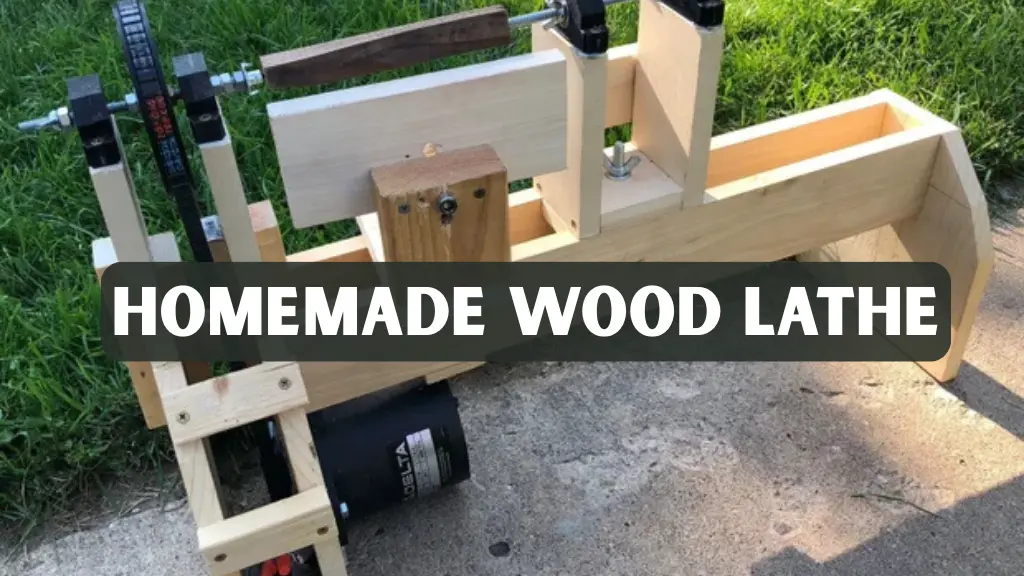Woodturning is one of the most rewarding woodworking techniques because it allows you to shape, smooth, and carve wood into functional or decorative items. While professional lathes are widely available, many woodworking enthusiasts prefer creating their own machine. Building a homemade wood lathe not only saves money but also provides a deeper understanding of how the tool works, offering greater flexibility and customization for specific projects. This guide explores the process of constructing a lathe, the materials and tools required, safety considerations, and practical tips for getting the most out of your setup.
Why Build a Homemade Wood Lathe?
Creating your own lathe gives you complete control over the design, size, and speed of the machine. Instead of investing in an expensive factory-built tool, you can use affordable materials and repurposed parts to create a fully functional piece of equipment. This approach also allows you to tailor the machine to your workspace and woodworking goals. Some builders focus on small, detailed projects like pens or ornaments, while others construct heavy-duty machines capable of handling table legs, bowls, or spindles.
Another advantage of constructing your own lathe is the opportunity to learn through experience. Assembling one requires knowledge of mechanics, alignment, and safety considerations. By taking on this project, you gain hands-on skills that deepen your woodworking expertise. Furthermore, if something breaks or needs adjustment, you are already familiar with the structure and components, making troubleshooting easier.
Key Components of a Homemade Lathe
A homemade wood lathe consists of several essential components that work together to achieve precise woodturning. The bed forms the foundation, providing stability and alignment, which is vital for both safety and accuracy. The headstock contains the motor and spindle, delivering rotational force to the workpiece, while high-quality bearings reduce wobble. The tailstock supports the opposite end of the wood, sliding along the bed and locking securely in place for longer pieces. Knowing these components and how they interact helps woodworkers produce professional-quality results.
The tool rest offers a stable platform for chisels and gouges, allowing fine control over cuts. It should be adjustable in both height and distance to suit various turning projects. The motor, typically ½ to 1 horsepower for small to medium tasks, powers the spindle, while belts, pulleys, and bearings ensure smooth energy transfer. Using high-quality parts and proper assembly demonstrates expertise and trustworthiness, providing a reliable and durable machine. Building a lathe also gives hands-on experience with mechanics, alignment, and woodworking safety.
Materials and Tools Required
Constructing a functional lathe requires a combination of wood, metal, and hardware. Hardwood such as oak or maple is ideal for the bed and frame because it can resist vibration and maintain alignment. Steel rods with bearings form the spindle and tool rest. A motor, often repurposed from an appliance or purchased secondhand, provides sufficient power for the intended projects. Fasteners including screws, bolts, and nuts hold the components together, while belts and pulleys transfer motion from the motor to the spindle.
Common tools used in assembly include a table saw or circular saw for cutting wood, drills for holes and fasteners, wrenches and screwdrivers for assembly, and measuring tools such as squares and calipers to ensure precise alignment. Angle grinders and sanders are useful for smoothing surfaces and removing rough edges. Using proper tools and following safety guidelines ensures a reliable and efficient homemade wood lathe. Safety equipment is essential, including goggles, gloves, and dust masks, to protect the builder throughout the construction process.
Planning and Design Considerations
Stability is the most critical factor when planning your lathe. A poorly constructed frame will vibrate during operation, resulting in uneven cuts and a risk of accidents. Many builders reinforce their bases with cross-bracing or add extra weight to the bottom to improve rigidity.
The motor and drive system must also be considered. A variable speed motor allows the operator to adjust spindle speed for different project sizes and wood types. Low speeds are suitable for rough shaping large pieces, while higher speeds help in finishing and detailed work. If a variable speed motor is not available, using multiple pulleys can provide a range of speeds to maintain control.
Alignment between the headstock and tailstock is essential. Even a small misalignment can cause the workpiece to wobble, making precise turning impossible. Tool rests should be adjustable and lockable to provide safe support for turning tools. Safety features, such as emergency stops, guards, or shields, are strongly recommended to prevent injury.
Step by Step Guide to Assembly
The process of building a homemade wood lathe begins with constructing the base frame. Use heavy wood or metal to ensure rigidity and prevent vibration, which is essential for precision and safety. Reinforcing the frame with cross supports improves stability during operation. Once the base is complete, securely mount the motor and headstock, making sure the spindle aligns perfectly with the bed. Proper alignment at this stage lays the foundation for accurate and consistent woodworking.
Installing the spindle and bearings is one of the most critical steps. The spindle must rotate smoothly and without wobble to achieve precise cuts. For the tailstock, ensure it slides easily along the bed and locks firmly in place. Adding a live center or bearing support allows the workpiece to spin with minimal friction, providing consistent results during turning. Careful installation ensures the lathe operates safely and efficiently.
The tool rest should be installed last, with the ability to adjust both height and distance from the wood. After assembly, test the lathe using a small scrap piece to check for smooth operation and proper alignment. Fine adjustments may be necessary to reduce vibration and ensure the headstock and tailstock are perfectly aligned. This step-by-step approach helps woodworkers achieve reliable performance and professional-quality results.
Safety Considerations
Safety is paramount when operating any lathe. Proper construction is the first step, but consistent attention to safety practices is necessary. Always wear protective goggles and a dust mask to protect your eyes and respiratory system from flying debris. Gloves should generally be avoided while operating the lathe because they can catch in spinning parts.
Before turning a workpiece, ensure it is securely fastened. Never leave the lathe running unattended. Keep the workspace clean and free from obstacles, and ensure all tools and accessories are organized to prevent accidental contact. Start at lower speeds until you are comfortable with the machine’s operation. Regular inspections for loose bolts, worn bearings, or damaged belts can prevent accidents and maintain performance.
Practical Benefits of a DIY Lathe
Building your own lathe provides several advantages. One of the most significant is cost savings. Commercial lathes are often expensive, but constructing one using repurposed materials or budget-friendly supplies can dramatically reduce costs.
Another advantage is the ability to customize the lathe according to your projects. You can adjust bed length, motor type, or even the configuration of the tool rest. Additionally, building a machine provides a unique learning experience, enhancing your woodworking skills and mechanical understanding. With proper care and maintenance, a DIY lathe can last for many years and handle a wide range of projects.
Real-World Examples and Applications
Many woodworkers share their homemade lathe projects online, demonstrating the variety of designs and capabilities. For instance, some hobbyists repurpose washing machine motors to create reliable variable-speed machines. Others use treadmill motors for larger, heavy-duty setups. Projects range from small pen turning to large bowls, table legs, and decorative spindles.
A notable example involves a woodturner building a compact lathe specifically for pen making. By using scrap metal and wood, he created a professional-quality machine at a fraction of the cost of commercial options. Another woodworker constructed a full-sized lathe capable of producing large furniture components using steel beams and a high-powered motor. These real-world examples show that homemade lathes can be versatile and highly functional.
Common Challenges and Solutions
Vibration is a common challenge with DIY lathes. Reinforcing the frame or adding weight to the base can significantly reduce movement. Misalignment between headstock and tailstock is another frequent issue, which requires careful measurement and adjustment during assembly.
Sourcing suitable motors and bearings may also be challenging. Many builders overcome this by visiting salvage yards or appliance repair shops for used, high-quality components. Safety is always a concern, and addressing it requires careful inspection, proper assembly, and routine maintenance to ensure reliable performance.
Maintenance Tips
Routine maintenance extends the life of your lathe. Clean the machine after each use to remove dust and wood shavings. Lubricate bearings, spindles, and moving parts regularly to minimize friction and wear. Check all fasteners for tightness and inspect belts and pulleys for damage. A well-maintained lathe not only improves safety but also ensures more precise turning. Proper storage in a dry, controlled environment prevents warping or rusting of components.
Conclusion
Creating a homemade wood lathe is a rewarding and educational project that combines woodworking, engineering, and creativity. It offers opportunities for cost-effective customization, hands-on learning, and developing a deeper understanding of mechanical alignment and turning techniques. Careful planning and attention to detail during construction ensure the lathe performs reliably and safely across a variety of projects.
With proper maintenance and adherence to safety practices, a DIY lathe can deliver high-quality results for many years. Woodworkers benefit not only from a functional tool but also from the expertise and confidence gained through the construction and operation process. This combination of durability, skill development, and personalized design makes a homemade lathe a valuable addition to any workshop.
Frequently Asked Questions
Is a homemade lathe safe to operate?
Yes, provided it is constructed properly and maintained regularly. Extra caution is needed compared to commercial lathes because build quality depends on the builder.
How much does it cost to build one?
Costs vary depending on materials and whether parts are new or repurposed. Small builds can be under $100, while larger, high-quality versions may cost several hundred dollars.
Can it handle large projects?
Yes, if designed with a strong frame and adequate motor power. Large bowls and furniture legs can be turned successfully on a well-built machine.
What motor size should I use?
For small projects, a ½ HP motor is sufficient. For medium to large projects, 1–2 HP motors are recommended. Variable speed options improve versatility.
How can I check alignment?
Mount a test piece between the headstock and tailstock. If the wood spins evenly without wobbling, your alignment is correct. Adjust as needed.




